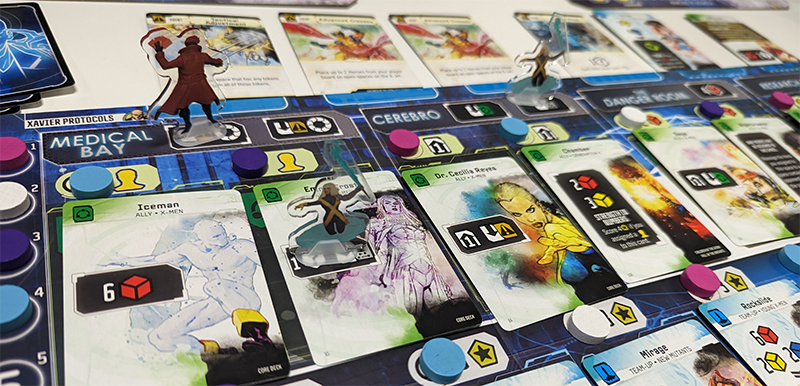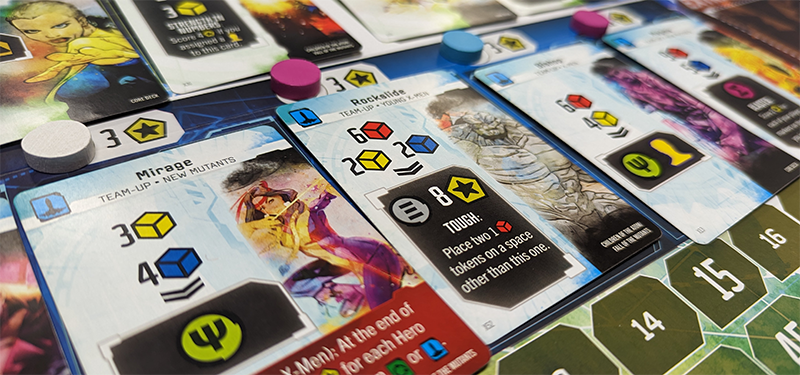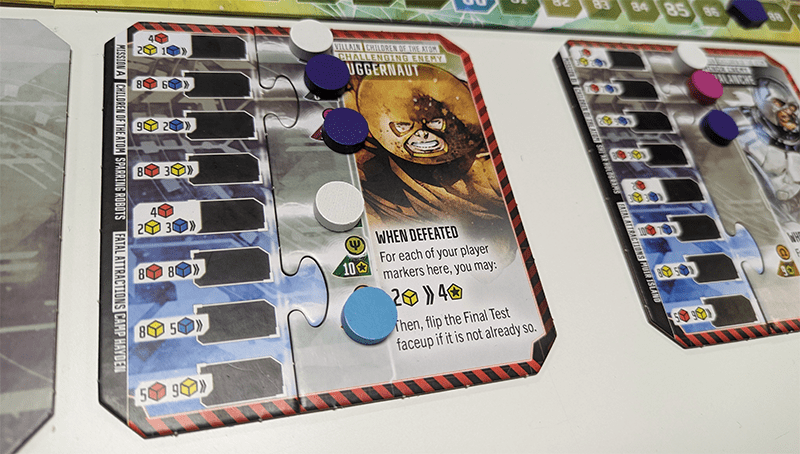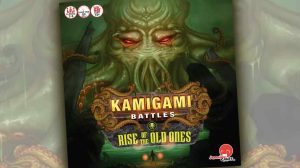Disclosure: Meeple Mountain received a free copy of this product in exchange for an honest, unbiased review. This review is not intended to be an endorsement.
I know it’s cliche to bring up nostalgia or childhood memories when it comes to intellectual properties that are old enough to run for the US presidency, but I have to here. Marvel, more specifically the X-Men, was a major reason I was briefly into comics and appreciate long-form storytelling. I particularly loved the individual stories of each character, how they interacted with each other, and how they grew over time.
The world building of the X-Men universe was also something I enjoyed, as it brought fantastical elements into an urban setting. This appreciation manifested into reading fantasy novels like Lord of the Rings and Redwall, both of which I read with great enthusiasm. I found myself drawn to stories with larger than life characters and epic battles between good and evil, something Marvel was able to provide in spades. Although my foray into comics didn’t last long, Marvel made an indelible mark on me that still carries into my adulthood.
When I received a review request from WizKids to look at this worker placement game set during the golden era of X-Men, declining the offer was impossible, even though this is a genre I don’t typically enjoy.
And, can I point out that I can finally enjoy a Marvel game that doesn’t require me to cooperate with others?

Playing for keeps is still playing, mon ami
Now, this would be the part where I discuss the fundamental plot or theme of the game, but Marvel: Age of Heroes contains three scenarios. For the purpose of this review, I’m going to limit myself to the introductory scenario wherein the X-Men are undergoing training. Usually the word “scenario” means static, but that isn’t the case here as the villains you face off come from a large stack of tiles, so plenty of variety here.
The first thing you and your friends will do is pick your favorite pair of X-Men, which should be Gambit and Rogue if you have excellent taste like yours truly. As well as starting resources, each pair has their own Evolution cards, which are fancy words for passive powers.
There are three resources: Physical, Mental, and Willpower. The general gameplay loop here is you will gather resources, send your heroes to the X-Jet, then spend those resources to damage the villains for points. If this sounds like Lords of Waterdeep, it should, because the co-designer of Lords of Waterdeep worked on this one.
In each round, there is an Institution phase, followed by a Mission phase. During the Institution phase, players must acquire resources in order to be successful in the Mission phase. However, in order to take part in the Mission phase, one of the player’s Hero pieces must be sent to the X-Jet.
When the Mission Phase begins, players who sent their pieces in the X-Jet earlier will be the first to act, sending their pieces to attack the Villian either on the Mission Tile or Team-Up card, or head to the Extraction Zone for additional resources and actions. Once everyone has placed their Hero pieces from the X-Jet, the round ends.
Your turn involves selecting one of your pieces from your player board and placing it on an action space on the central board. These action spaces enable you to alter the turn order, play cards, draw cards, or obtain resources. It should be noted that once an action space is chosen by a player, it cannot be claimed by any other player.
Until now, what I’ve described hasn’t been too different from every worker placement game, so what’s up? Let’s talk about the Xavier Protocol cards.

The X-Men don’t give up. They stand up.
You start with three of these cards in your hand, and they come in three varieties. Event cards are the simple “do the text and discard” type that we’re all familiar with. The other two are Ally and Team-Up cards. There are several spaces on the board where you can place them, but what do they do? They provide more spaces to place your workers to gain resources or alternative ways to damage the villains, and if the other players use your cards, you get a bonus such as extra resources or drawing cards. Yes, this is identical to the buildings in Lords of Waterdeep.
No exaggeration, but when I read this in the rulebook before my first playthrough, I immediately knew this was going to be one of my favorites because it solves one of the many issues I have with the worker placement genre. It’s like the game designer went into my dreams, pulling off a Freddy Kreuger, but instead of murdering me, he made a board game based on my frustrations with the genre.
The game does not come without its shortcomings, and I’ll discuss those later, but for now let’s focus on what’s good.
A major problem I’ve always had with the worker placement genre is the obvious decisions. You score points by collecting and using specific spaces in a particular order. The only obstacle is simply someone taking it before you do because of the turn order. To me, it’s such a boring design.
Marvel: Age of Heroes eliminates this mess with the use of Team-Up and Ally cards. With these cards, you and your friends are creating a communal potluck for everyone to enjoy and giving numerous alternatives outside of the basic spaces. Creating opportunities arises from everyone’s contributions, but instead of being left to your own devices, you build something for everyone to engage in. Considering all of these spaces are from a deck of cards, this means every single game is going to have a different set of action spaces to exploit. In Marvel: Age of Heroes, you are always progressing, but maybe not at the same pace as your opponents.
The design of some of these Ally and Team-Up cards is also clever. One area you’ll learn quickly is if the spot gives you nearly double what you usually get from the basic spaces, there is a compromise in the form of tokens such as victory points or resources. These tokens are placed in other action spaces and the next person to use that action space also claims these tokens. That decision is never easy to make.

To me, my X-Men
I wish my frustrations with the worker placement genre did not end there. Another grievance I have is the “strategy” of obtaining more workers. Any worker placement game that provides you with a space that permanently gives you additional workers will always be the first thing you want to do. If you get more workers, you will get more actions, thus more resources to gain more points. It is a painfully obvious move.
Marvel: Age of Heroes gives you the opportunity to use Student pawns as extra workers. Unlike your Hero pawns, Student pawns won’t use most of your Evolution cards. Some action spaces offer round-end bonuses, and your Student pawns can’t take advantage of these. At the end of each round, your Student pawns are not returned to you, but rather to the supply. However, there are Event and Ally cards that allow you to turn in your Student pawns for points if you don’t find much use for them. It’s almost as if the designer thought of everything!
Evolution cards are a particularly interesting feature in the game. Each pair of Heroes has its own set of Evolution cards, which are designed to specialize in different areas. Initially, players do not possess any Evolution cards and must use action spaces to play them. While the first one or two Evolution cards are free to play, further ones require you to pay a cost. This encourages thoughtful, strategic play in order to ensure the most efficient use of resources. Furthermore, the Evolution cards give the Heroes their own identity.
Taming Lockheed
For example, Magik earns a lot of points for filling her six Evolution card slots. Wolverine and Jubilee love to abuse Team-Up cards to cause a lot of damage to the Villains. Kitty Pride and Lockheed can interact with spaces that are already occupied, while Gambit and Rogue take advantage of the tokens placed on the board. Storm and Forge earn points for Student pawns and can hold 5 of them. I would tell you what Cyclops and Jean Grey do, but my friends have good taste, so they never chose them.
I talked a lot about the good in the game, but what about the bad? This wouldn’t be a proper board game review if I didn’t complain about the rulebook.
On the surface level, the rulebook does a good job of explaining the flow of the game. Place a worker, get resources, once everyone passes, players in the X-Jet do their Mission phase, and the round is done. Easy.
So you read the rulebook, feel confident, teach your friends, and get your three starting Xavier Protocol cards. You and your friends take a good look at the cards and without warning, questions attack your mind as if Professor Xavier had beef with you.
What exactly is a location? Is the X-Jet a location and an action space? Do you grab the tokens before doing the action?

Let’s go to work then. We have a world to save.
It may sound simple, and the rulebook does indeed explain the rules. The issue is that the rulebook scatters this information all over the place instead of emphasizing its importance. Almost every card in the game breaks a rule, and it is difficult to break the rules correctly if the terminology is not explained well. It is not the worst rulebook I have read, but it could have been much better.
The biggest issue is the player scaling. When playing with two to four players, the total number of Hero pieces is 12; for example, if two players are playing, each player will receive 6 Hero pieces. When a fifth player is added, the total number of Hero pieces increases to 15. This change results in each player contributing fewer cards to the board, making downtime more noticeable and causing more rounds to be played since each player has fewer resources to fight off the Villains. Five player games mask the game’s strengths, like a bodybuilder in loose clothing.
Marvel: Age of Heroes may look simplistic, but it’s frugal with its resource generation. This can cause the first few rounds of the game, with its low number of Ally cards in play, to feel like a grind since four player games only have three workers to play with and don’t get the high output of resources the players need. Fast players can make this less of an issue, but if the group doesn’t think their moves through quickly, game time concerns can arise.
The box does proudly states that the game will take 60 to 90 minutes, but this only applies if the players are skilled. Since there is no round limit, the game could go on for longer if the players don’t use their workers efficiently. We experienced this firsthand, as our first two games lasted over two hours. However, when we played with the same group again, we finished the game within 90 minutes once we knew what we were doing.
When I first saw the game, I was hesitant due to its genre, but I’m so glad I gave it a chance. Not many worker placement games offer this level of interactivity, and even more rare are those that allow players to create options for everyone else. This collaborative atmosphere really brings something special to gameplay; every game is different with all sorts of options for everyone to participate in. Marvel: Age of Heroes encourages players to explore and take advantage of the variety of possibilities presented to them, and any game that can make that happen deserves my respect. Definitely a surprise hit for me.











